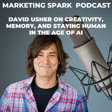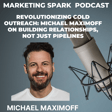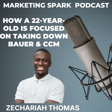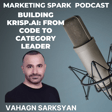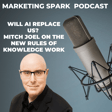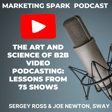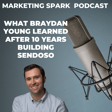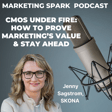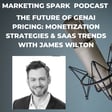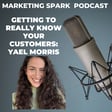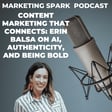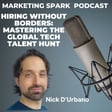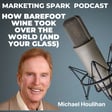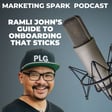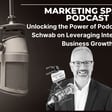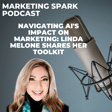Become a Creator today!Start creating today - Share your story with the world!
Start for free
00:00:00
00:00:01

Conversion Copywriting Strategies: How Chris Silvestri Boosts B2B Marketing Success
In this episode of Marketing Spark, host Mark Evans sits down with Chris Silvestri, a conversion copywriting expert, to explore the art and science of crafting high-converting messages.
They discuss the psychology behind effective copy, how to blend storytelling with data, and practical strategies B2B marketers can use to drive engagement and sales.
Tune in to gain actionable insights that will transform the way you approach messaging and marketing.
Transcript
Introduction to Marketing Spark Podcast
00:00:10
Speaker
It's Mark Evans, and you're listening to Marketing Spark. In a crowded SaaS landscape where new products literally launch every day and attention spans are shorter than ever, strong messaging isn't just important, it's essential.
00:00:26
Speaker
The best product in the world won't succeed if customers don't quickly understand what it does, why they should care, and as important, how you're different or better.
Expertise of Chris Silvestri
00:00:38
Speaker
That's where Chris Silvestri comes in. Chris helps B2B SaaS companies refine their messaging so they can stand out, connect with the right audience, and drive real business results. With a background in copywriting, UX design, and conversion optimization, he blends psychology, storytelling, and strategy to craft messaging that resonates.
00:01:00
Speaker
As the founder of Conversion Alchemy, he works with startups and growth stage companies to turn confusing or forgettable positioning, and there's lots of that out there, into clear, compelling narratives.
00:01:12
Speaker
If your messaging isn't working as well as it should, Chris has some great insights on how to fix it. Welcome to Marketing Smart, Chris.
Transition to Conversion Copywriting
00:01:20
Speaker
Hey, Mark, thanks so much for having me ah You started your career as a software engineer before moving into conversion copywriting.
00:01:27
Speaker
It's an interesting career shift. What sparked that transition and how has your technical background shaped the way you approach messaging and positioning for SaaS companies?
00:01:39
Speaker
How did I shift from software engineering into marketing, basically, and copywriting and messaging? What a lot of people think when they hear you were software engineer and transition to copywriting for SaaS specifically, they think you know the software space.
00:01:54
Speaker
perfectly the SaaS space is where you were living before. The thing that a lot people don't know is that my type of software engineering was in a totally different field. It was software engineering in industrial automation.
00:02:08
Speaker
So think of... those automatic assembly machines that assemble components in factories, right? I used to program those so that operators could use these machines and and and basically replace human labor.
00:02:24
Speaker
That was my job. i was programming this. It was mostly logical programming, lots of sensors to... wire with the software to understand how those sequences moved and combined. The way that I shipped it from that was totally random. I wanted to play more with my band. I'm a drummer.
00:02:45
Speaker
I decided, let's look for something to make money online that's flexible, that allows me to travel, and I don't have to wait three months to take time off to go on tour.
00:02:56
Speaker
And I stumbled on copywriting. The thing that I enjoyed most about copywriting was the psychology behind it, the decision-making process. It's not only about writing words or designing websites. It's about understanding people. That's the thing that actually grabbed me still to this day, makes me passionate about it.
Challenges with Generic Messaging
00:03:18
Speaker
You got experience working with more than 50 B2B SaaS companies like Moz. What are some of the biggest mistakes that you see companies making with their messaging from the outside looking in and someone who spends a lot of time focused on positioning and messaging? There is an awful lot of confusing, generic, undifferentiated messaging.
00:03:41
Speaker
And I wonder how could a company operate like that in an ultra competitive landscape? How could the head of marketing or the CEO for that matter live with messaging that doesn't differentiate, that doesn't motivate or inspire prospects to at least check out what they're doing instead?
00:04:01
Speaker
They're running with one hand tied behind their back. You can run, but certainly not as fast. Why do they struggle with bad messaging? Is it ignorance? Is it they don't care? Do they think that their product is good enough? What are the reasons behind bad messaging?
00:04:15
Speaker
Why they struggle with bad
Importance of Cohesive Messaging
00:04:17
Speaker
messaging? It's a great question. i think it's very nuanced, contrary to what a lot of people think. You mentioned, are they passionate about their products, their messaging? It's actually the opposite. A lot of my clients are super passionate about their products, whether it's the marketing department, sales, or or the founder especially.
00:04:35
Speaker
I think the main problems that I'm seeing is, first, there's a lack of alignment between teams. So whether it's change teams, marketing, founder, marketing, sometimes support as well.
00:04:48
Speaker
There's a lack of alignment in terms of messaging. And this, I can tell you an example of this that happened recently. So I've been working with this SaaS based in France, but they recently got acquired by the by a private equity firm.
00:05:02
Speaker
So you can imagine someone comes in, basically buys them out, and now you have two completely different teams that need to synchronize and agree on how to say what they do and for who they do it.
00:05:15
Speaker
So our job as messaging experts, copywriters, it's to come in and and show them and and have all their knowledge come to the surface, bubble up to the surface, so that everyone in the team realizes, oh, is this really what we're about?
00:05:35
Speaker
okay, this is the way that we should say Because otherwise, teams have a hard time communicating. Someone says what they do in a completely different way than someone else. So you need that kind of alignment internally, I think.
00:05:49
Speaker
Another reason it's which actually stems from this is the They don't have clear positioning and messaging
Positioning Strategy Essentials
00:05:57
Speaker
strategy. lot of people think about copywriting as just, okay, I'm going to sit there, I'm going to write, or I'm going to use this brand voice guidelines, and that's done.
00:06:06
Speaker
But the thing is, yeah unless you do the work at the surface, which is the positioning strategy, which is basically saying what you do, who you do it for, and how you do it in a unique, better, differentiated way. Unless you know that, everyone in the team knows that.
00:06:23
Speaker
And unless you turn all of that into a messaging framework, which is how then you say all of it, You're writing copy, it's impossible. Or you're just guessing, right? Or you're just prompting ChatGPT asking, hey, write me this landing page.
00:06:38
Speaker
ah i think that's right that's what a lot of companies are doing nowadays. They need that kind of foundational work. Another reason is they're copying competitors. So it happened a lot of times when I jump into new projects.
00:06:54
Speaker
For example, ha had this in a very crowded space, the data data integration quality space. this company, i jumped in and they showed me, okay, this is our V1 beta messaging that we think of using, right?
00:07:11
Speaker
Then I go and look at all their competitors. We usually do a competitor analysis to contrast the different messaging. And it was exactly the same claims. And then we go into the positioning and messaging work that I've described before. That's when you actually realize, okay, all of the other competitors are saying the same thing. So how
Adapting Messaging Strategies to Market Changes
00:07:30
Speaker
are we different? right So that's the other thing.
00:07:34
Speaker
Finally, probably one last mistake that I see them making, it's that they're even if they have a good positioning messaging strategy, that's set in stone, which means that they don't rework it when there are certain triggers, which I think you should typically revisit, rework your positioning messaging strategy, either when there's a major major market change or maybe new competitors pop up.
00:08:00
Speaker
or you have a product people that you want to look into and adjust for, or worst case, like every six to 12 months, you should probably revisit your strategy.
00:08:11
Speaker
Great advice and something that I advocate for because positioning is very fluid. It's very dynamic and same for messaging. It's not written in stone. Just wanted to circle back with your comment about competitive undifferentiation and the tendency to say what every other competitor is saying. And there's the old saying that it's a lot of, it's easier, it's easier to run with the Buffaloes and run off the cliff.
00:08:37
Speaker
than it is to stand out by he yourself. It's hard to zig when everybody else is zagging. No one ever made a mistake by an a IBM. There is less risk involved when you're not saying something different. Your CEO is not going to point to the head of marketing and go, yeah what are you doing? Everybody else says this and you're saying that. Is it?
00:08:56
Speaker
a fear of risk? Is it a lack of being courageous or creative or bold? What undermines companies when it comes to their messaging and the fact that they sound like everybody else? And I run into it. The reason or reasons why a lot of companies tend to copy their competitors is yes, some of it, I think it's, they don't want to risk it, especially In B2B, you might think, oh, yeah, it's all about the company. It's all about like logically, but it's also the like the personal side. You like you you might risk your job if something goes wrong.
00:09:30
Speaker
So that's that's one factor. But I also think sometimes what I'm seeing is lack of knowledge about how to turn a lot of the research data into actual differentiated, crystallized messaging. Because a lot of the clients that I'm working with When I asked them, hey, can you share past research, deep conduct? A lot of them have really good survey data. Maybe they have a lot of sales calls recordings or gone recordings.
00:09:59
Speaker
So we can look at those and understand. But they don't actually put all of that data into practice. stays on They don't operationalize the data, which is a shame because when we jump in and we listen to all those sales calls, it's gold.
00:10:13
Speaker
every Everything that customers say on on calls or interviews that we run, you can extract a lot of great voice of customer that that you can use to to actually do that differentiation work that competitors are probably not doing.
00:10:30
Speaker
The other challenge for a lot of BDB SaaS companies when it comes to messaging is that They're trying to appeal to decision makers and end users.
00:10:43
Speaker
Often they have different mandates. A decision maker, for example, is looking to scale or reduce expenses. Bottom line matters to them. The user, the person in the trenches is looking for something that allows them to do their jobs easier or faster. And sometimes their goals are different.
00:11:04
Speaker
They're trying to work towards the common good, but their goals are different. How do you create that message market fit where what a company says can appeal two different audiences, different types of people within the buying process,
Achieving Message-Market Fit
00:11:24
Speaker
but aligns them in the same way? It's a challenge to make sure that people get what they need, but there's a common story that they're telling to the marketplace.
00:11:32
Speaker
How do you get to message market feed? The way that I define it, it's joining the conversation already happening in your prospect's mind, which is it's contrary to what a lot of people think.
00:11:44
Speaker
People don't land on your website and want to know exactly what do you do, they they already have some kind of conversation or ideas or pain points, desire outcomes in their minds, and they want to see those matched on the page as soon as they land.
00:11:59
Speaker
And then, okay, if that works, then they're going scroll. So in order to find that out, I always say the biggest component of a messaging project, which sometimes startles clients, is that 70% of the work is the research.
00:12:17
Speaker
So the way that I divide, actually prioritize research, so i actually have a system for prioritizing research for my clients. It's dividing it into three layers, let's call it. We have the first layer, which I call the the the surface layer, let's say it it's what what users say.
00:12:36
Speaker
And if you don't have this data, it's the easiest, fastest data to collect, which is looking at review websites online, looking at other competitors' websites, Maybe you have already have surveys, NPS surveys that you can look at. So anything that's already available that tells you, okay, this is how our customers, whether it's end users or decision makers, this is how they speak.
00:13:00
Speaker
And we can use it, mirror mirror it on the website. That's already lot of the good work. The second layer, it's the kind of the structural layer, let's say, which in my case, I really associate with the UX work that I do.
00:13:15
Speaker
And this is what users do on the website. So to understand this, you look at how they navigate through the website. Maybe you have heat maps, user interaction data installed on the website so you can understand the the patterns that they go through.
00:13:31
Speaker
You can understand the... ah the the user flow through the website pages, so that's super important as well because you have to know when to present what content to them.
00:13:42
Speaker
The final layer is the deeper layer. This is why users act. And you get this data by doing the hard work, which is interviewing customers,
00:13:53
Speaker
or running your own surveys. But but there's also nuanced aspect to this, which is not really asking them about when you do interviews, you you don't ask them, Hey, what do you like about this product? or What could we do better? Okay, that's all good.
00:14:08
Speaker
But what you need to understand here is that decision making process. And that's what tells you, okay, this is where We need to differentiate our messaging for the users, for example, from check signers or from managers. so all of those little nuanced differentiations, you understand them by doing but going through these three layers that give you much more insightful and useful data that you can use.
00:14:37
Speaker
Great insight. One of the things that I'm really curious about when it comes to positioning and messaging is understanding why someone would change how they're doing their jobs on a day-to-day basis, because change is challenging. It's daunting.
00:14:56
Speaker
Some people look at change and simply say, i don't want to change. I like the tools that I have, even though they're not perfect. In fact, they could be far from perfect. And change is intimidating because it means learning new ways of doing things.
00:15:13
Speaker
I guess one of the obvious questions here is how do you inspire, encourage, educate someone that ah about what's possible and that change can be a ah very positive thing as opposed to something to be afraid of?
00:15:28
Speaker
For example, we write a page for a website. There's a couple of sections ah kind of a specific flow that we go through and always towards the end of the page, I always think of it as the anxiety reducing section of the page, which helps Addressing exactly as you said, the shifting costs, the shifting costs that people incur in obviously considering another solution.
00:15:55
Speaker
And to understand that, obviously in our research customer interviews, we ask those questions. Like we ask when you were evaluating to current customers, when you were evaluating the product. Were you considering alternatives?
00:16:07
Speaker
What did you like about those? What you didn't like? And then after you pick the product, were you still evaluating those to understand what the retention patterns are as well? So that's super important. And a lot of the the work that you would do in that anxiety section, shift switching cost reduction section, it's Also, including social proof, they need to identify with the exact social proof they place on the website. So if they see that you are writing for a CMO, if they see testimony from another CMO or a case study that speaks to the exact either use case or specific problems that they had, that's super helpful.
00:16:48
Speaker
But another thing is going deeper into, for example, the use cases. So if they see that they can realize a specific use case that they need much better with this, with your product, than they can do with their current solution, then the switch almost becomes automatic, right? If the price makes sense, like those come later at the stage.
00:17:11
Speaker
But yeah, I think it's super important. and It's a great point to make sure that you address
Educating Clients on Messaging Strategy
00:17:16
Speaker
those switching costs. want to go back to a point that you made about research and that 70% of the work that you do is behind the scenes.
00:17:27
Speaker
Yeah. It's grunt work, it's necessary work, but often companies will look at a position in your messaging exercise and they'll see the deliverables.
00:17:37
Speaker
And a reaction may be, that's it. That's all I get. You're charging me all this money. you're It takes all this time. and at the end of the day, the deliverables are ah appear to be minimal.
00:17:49
Speaker
I don't mean to undermine what we do, but lot of people are looking for outcomes and results. And they often think that I'm going to get this big deck with lots of great insight and my website's going to be completely overhauled and it's going to be amazing.
00:18:04
Speaker
But often that's not the case. How do you educate customers and prospects about your process. And the fact that a lot of the stuff that happens is sort of operates underneath the surface. It's kind of like watching a duck on a lake.
00:18:19
Speaker
The duck looks really calm and cool and collected, but underneath the surface, it's furiously moving its feet because there's so much happening. So what is that education process when and people ask you how you work and what they get?
00:18:33
Speaker
Yeah, so how how do I educate clients on my process for positioning and messaging? i actually It's actually interesting that ah client mentioned to be the the duck syndrome like speaking to one of their customers, so their customer situation or problem.
00:18:49
Speaker
But yeah, so the the biggest thing, i think it's actually making it clear from the get-go that, and I always do it, like I always tell them, we are going to get to the positioning exercise probably after like in a month and a half after we've done all the research.
00:19:05
Speaker
And before even sending them doing the positioning exercise, we deliver a research report or report of findings and insights so they they can see the work that we've done to get to that point.
00:19:18
Speaker
But the other thing, it's also making it clear that There's a great book, that i one of my favorite books, that's called The User the user Illusion.
00:19:30
Speaker
And a phrase in the book says, making things easy is hard, clarity requires depth. And thats the that's the gist of the whole positioning exercise. in order yeah It's a one-pager at the end of the day.
00:19:46
Speaker
But those words our are basically the the words and the structure that's going to carry you over through all the work that's after, whether it's the messaging framework and the copy that comes after. So once you have that clear together with the team, that's the the plus value. It needs to be clear to everyone.
00:20:08
Speaker
And that's what what's missing in most companies. Once that's clear, then writing comes almost natural.
00:20:15
Speaker
We've talked about how a lot of B2B SaaS messaging is generic, uninspiring looks and feels like every other competitor in the marketplace.
00:20:30
Speaker
One of the challenges that a lot of companies have is trying to define differentiation. In ultra-competitive marketplaces, differentiation is crucial.
00:20:42
Speaker
What strategies do you use to help brands stand out and avoid sounding like everybody else? How do you help them discover how they're unique or different or better?
00:20:54
Speaker
And what are some of the challenges that you run against when you present an idea of differentiation and a client will go, no, that's that's not us. We don't operate less because they're so inherently biased. They've lived with their messaging for so long that they have a hard time seeing what's over the horizon.
00:21:14
Speaker
The way that I help my clients understand their differentiation, it's first, just the the simple fact of being an outsider helps me and them get more of an objective view on the company, the product, the customers. That in self is super valuable, I think.
00:21:32
Speaker
But the other couple of things that I do, one is understanding and kind of extracting from them because sometimes they keep it hidden, extracting their point of view, especially from the founder. If the founder scratch their own itch or they've been in the industry for a long time and they have a very strong point of view or insight into the industry,
00:21:55
Speaker
that's super valuable to differentiate the the messaging. A lot of times the product might be pretty much the same as other companies, but what differentiates it, it's the approach and the point of view. Where are they coming from?
00:22:10
Speaker
How are they delivering their product in a way that's different from other companies? Sometimes it's very subtle. But if you can find it, it's very helpful. The other thing is finding their unique voice. Sometimes what resonates is not really what you say, the features, the benefits, but it's it's simply the style, the different voice in which you say it, especially if it matches specific values that your customers share with you. Another thing is looking at competitors, but not copying competitors. The way that we do it, we do competitor analysis.
00:22:44
Speaker
And we analyze website competitors' websites' messaging, dividing it into these three areas is the last one. But before that, you have the value section and then up above that, the motivation section. Understanding websites this specific way, it's how you understand what level of awareness and sophistication are my competitors targeting.
00:23:08
Speaker
Should we target that same ah angle with our messaging or maybe slightly different? Even if your product is not that different, selecting a different approach or targeting mechanism for your messaging can help differentiate you.
00:23:25
Speaker
Finally, probably the easiest thing is that a lot of companies either don't do or don't do well, it's using voice of customers, I mentioned. So looking at reviews, looking at your customer interviews, any specific messaging that sounds sticky, let's say, is messaging that sounds like a headline that you could just take verbatim and use.
00:23:50
Speaker
That's super helpful because another a lot companies just use the usual jargon, especially enterprise company. So when you start writing conversationally in B2B, which is much less common than B2C,
00:24:03
Speaker
then you have a much easier time differentiating. It would be remiss if I didn't ask you about AI, because it seems to impact in everybody, everywhere.
AI's Role in Copywriting and Strategy
00:24:12
Speaker
And it's certainly changing the way that content and messaging are created. And for that matter, a lot of website content, you can tell is being generated by ChatGPT.
00:24:25
Speaker
How are you leveraging AI tools to enhance your copywriting and conversion strategies, as well as the research that you do to sort of underpin the work that you do for clients?
00:24:39
Speaker
So how do I use AI in my work? i say everywhere. i've i've I started probably a two years ago when ChatGPT3 was out, started experimenting from the get-go, seeing what used to get, understanding at the beginning that it sucked, didn't work, then slowly integrating it into my processes from every area, research, strategy, writing. a lot of people say that AI can't write a copy.
00:25:07
Speaker
But the the reason is that AI doesn't have the context. The things that I think are more important for you to use AI for messaging copy is to give the AI as much context as possible right from the beginning of the project. When I start a project, for example, for a client,
00:25:25
Speaker
I use a couple of different tools, but everything that I share with the client, so even like even the first strategy session before signing the proposal, I shared it with the AI. From that, we I shared the proposal. Then we go into a kickoff call. All the transcripts I shared with the AI, obviously censored, everything that needs to be covered. As long as I go through the project, the AI knows everything about the project.
00:25:51
Speaker
And I can ask it questions, I can strategize with AI. So it starts building up a knowledge base that it can use almost as if you were an assistant, right?
00:26:01
Speaker
So that's one way that I use it. Then the other way typically happens at the end of the project. Once I have the strategy in place, all my documents crystallized from real research, then I create a separate AI or chat that could be considered almost a simulation of a customer persona.
00:26:20
Speaker
A lot of people call it synthetic personas. There's different ways of calling it. The useful thing about this is that especially if you're a startup, maybe you don't have a lot of research data, you don't have the time or the money to conduct a lot of research.
00:26:35
Speaker
Using an AI persona like this, as long as you direct it with some of the strategy work that you've done, it's really helpful because even if you don't get to 100% accuracy, you can at least get to that 70, 80% that can inform initial strategy or copy.
00:26:54
Speaker
And then you can iterate from there. You can literally have a conversation with the AI, like if you were having like a focus group with a customer. So you can ask questions about, Hey, what objections would you have if you stumble on this piece of copy? Or you stumble on this headline and these bullet points. What do you think? Tell me your thought process. And then you can adjust based on what they say.
00:27:13
Speaker
You can literally simulate the AI going through an entire page of copy. And the feedback is pretty accurate if you do all the work upfront. and Yeah, I think we have similar approaches. I mean, I've been writing, I'm a writer, a reporter for a long, long time, and I have an antagonistic or ah ambivalent relationship with AI because people think that AI replaces writers. And in some respects, AI is getting smarter and smarter, in it will replace a lot of the writing.
00:27:42
Speaker
There's some writing that AI will not be able to replace. But Over time, over the last, since ChatGPT launched in November 2022, I've become more comfortable with it and embraced it as a key part of how I do my job.
00:27:55
Speaker
Like you, i do a lot of customer research. I do customer interviews, listen to gong calls, talk to executives. Everything is documented and I will feed it into a custom GPT for every client.
00:28:08
Speaker
I've got a living, breathing creature that knows my client inside out. When I ask for strategic and tactical guidance, it's not going out into the ether. It's in some respects working off the documentation that I've given it. It's almost like Frankenstein. You're trying to control the beast. So it's a really interesting battle. Admittedly, as marketers, we have to embrace...
00:28:32
Speaker
AI. We can't fight this fake battle and and recognize that it's going to do a lot of the work. I don't think it's going to replace marketers, but it'll be a great tool as we move forward. There are, however, some marketers that feel that AI generated content lacks originality and emotional depth.
00:28:50
Speaker
How do you balance AI driven insights with human creativity to craft messaging that converts and resonates? Yeah. So I think, as ah as I said, and the the way to actually have AI write well is to actually give it all the context that it needs. The way that I do it, for example, once we have all the strategy documents, we share them with, I typically use Claude, which is much better at writing. I think it's more human sounding, let's say.
00:29:19
Speaker
With the team, we use another tool called TeamGPT, where we can collaborate, we can share chats with the same project knowledge so that we can basically have the same voice. I could literally give it to a client and and they could write the copy title that I write sometimes.
00:29:35
Speaker
The thing is, if you don't do the work at the source, AI will always write content that's jargon, AI jargon, JGPT jargon.
00:29:46
Speaker
The way that I see it is having that human in the loop, in the sequence that always knows what stage you're at at the project, can intervene and can edit almost our jobs.
00:29:58
Speaker
As copywriters, I've become almost more of like editors rather than writers. A lot of the first drafts, AI is pretty good at giving them, but then you have to jump in with your own knowledge of the research and and know where to edit, what to edit, how to edit.
00:30:11
Speaker
That's key. The next step is going to be agentic workflows. For example, having an entire team of agents, every AI agent will probably do a specific targeted job, but which helps a lot with the limits that current commercial AIs like ChatGPT, Cloud have limit in terms of context response limit. That's probably going to be the next step. I'm already kind of working on it, on implementing some of those. so wanted to ask you about usability.
00:30:42
Speaker
We can craft words and messaging that say the right things that make an impact that capture people's attention and show that we're empathetic to their goals and challenges, but obviously UX plays a important role in getting people to like to take the next step, making it clear that here's what we want you to learn, but now here's what we want you to do, which is the one-two punch of messaging and conversion. How do usability and conversion go hand in hand? How do you incorporate UX and usability testing into your messaging process?
00:31:22
Speaker
to ensure there is a seamless experience for prospects.
Integrating UX Design in Messaging
00:31:26
Speaker
Yeah. The way that I integrate UX with copywriting messaging, it's it actually stems from my work. I use i also use the work at a usability testing startup. I did that for two years as a UX lead. so And actually, now that I think about it, a lot of the work that I used to do as a software engineer, I used to design this though the human one machine their interfaces, right? So the touchscreen displays that operators use to command the machines.
00:31:54
Speaker
So from there, I think I learned a lot of putting yourselves in your customers' shoes or in your users' shoes. And I started applying usability testing, not only for understanding how people use a product, but more towards the the website actually website experience. How do they consume the copy?
00:32:15
Speaker
Yes, you can you can do it looking at heatmaps, user recordings with something like Hotjar, but with usability testing, especially if you can find ah the right tester pool, so people that are pretty close to your target audiences, demographics, and psychographics.
00:32:33
Speaker
Then you can ask questions about, okay, hey, where would you go to find this specific information? Or everything about expectations. So what do you expect to happen before you click this button? And then when they click the button, ask them, do you think that the experience matched your expectations? So all of that work actually not only helps you, helps inform people.
00:32:56
Speaker
the way that you lay out the website the design, but also the way that you lay your copy out on the website. So a lot of the work that we do is wireframing. So we turn, for example, copy that's in Google Documents into wireframes, sometimes even clickable wireframes. So the clients can navigate through the Figma files. They can see, okay, from this page, I'm clicking this button. What's the next page? It's the...
00:33:23
Speaker
It's the UX sent. It's called the UX sent matched from where they are to where they land. um And especially when you have a lot of pages for B2B SaaS, you have you can have a lot of use case pages, solutions pages.
00:33:38
Speaker
It's important to understand the decision making process and the dynamics. of all different users, as you mentioned, the daily users, the decision makers, the check signers, how do they go through a website, what pages do they need to see and in what sequence. So we try to understand all of those with usability testing.
00:33:57
Speaker
Earlier, you mentioned the User Illusion as a must read book. Are there other books that you so would recommend. I'm curious about your tool set. What, what software do you use to do your job?
00:34:11
Speaker
I think a lot of people are curious about trying new things. What books do you read or you would you recommend people read and what tool would you recommend as well? I have one Well, second.
00:34:21
Speaker
This is a really good book that I started. It's called The Economic Naturalist. Why economics explains almost everything. And it explains all the different ways that simply framing things influences our decisions and how it's already happening all around us. It's a really good one that I've never heard a lot of people talk about. I think it was recommended by Rory Sutherland, Ogilvy, UK. As far as tools for AI, one not a lot of people know or use, it's Gemini 1.5 Pro, but I don't use it through the normal interface when you Google Gemini.
00:34:59
Speaker
you get to a normal interface, which is kind of like ChatGPT. I use it through Google AI Studio. You can use Gemini, their paid model, 1.5 Pro, their two Flash. that You can use it for free with Google AI Studio. I've been using it for free for a year and a half now, which is crazy to me.
00:35:13
Speaker
The great thing about that, it's the huge context window, which is 2 million tokens compared to ChatGPT, who's got 200,000. You can literally upload dozens, hundreds of transcripts, interview transcripts,
00:35:26
Speaker
all the research documents. I think the maximum that I've reached for a client project was 700,000 over the 2 million total. So I didn't even use half of it.
00:35:39
Speaker
So that's a good tool. The other one I mentioned, TeamGPT, but recently it's only enterprise. don't know why they shifted their model. The other one, Yeah, I would recommend Claude. If you want to start writing with AI, create a Claude project inside Claude with your research documents. It's not a huge amount of space.
00:36:00
Speaker
But if you have good synthesized research documents, then it's pretty good at maintaining the same voice and tone. This has been a great conversation. We've covered a lot of ground. where can people learn more about you and what you do?
Where to Learn More About Chris Silvestri
00:36:12
Speaker
You can find me on conversionalchemy.net, which is our website. I have a newsletter and a podcast as well, if you want to check those out. And I'm mostly on LinkedIn, if you want to connect.
00:36:24
Speaker
Thanks, Kristen. Thanks for listening to another episode of Marketing Spark. If you found this conversation valuable, let's keep the momentum going. Subscribe on Apple Podcasts, Spotify, or your favorite podcast app.
00:36:35
Speaker
Drop a quick rating and share it with your network. Your support helps more people discover the show. Running a B2B or SaaS company with a million to $10 million dollars in revenue and looking for strategic guidance to fuel your growth?
00:36:48
Speaker
Let's talk about how I can help you sharpen your positioning, optimize your marketing and scale with confidence as a fractional CMO and strategic advisor. Reach out via email, mark at markappens.ca or connect with me on LinkedIn.
00:37:00
Speaker
I'll talk to you soon.
